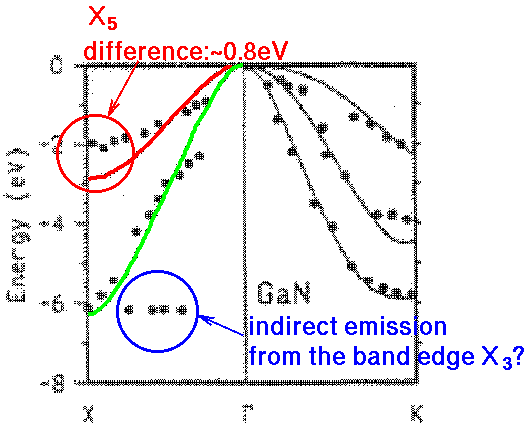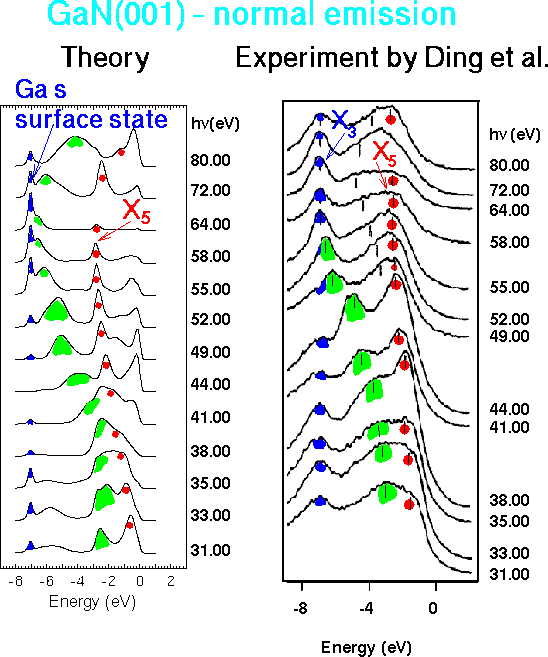|
Angle resolved ultraviolet photoemission spectroscopy (ARUPS) gives insight
into the valence band structure of the bulk as well as that of the surface.
In addition to the initial bound state the photoemission process involves the
excitation to outgoing scattering states. The following discussion underlines
that a full account of the resulting experimental data can only be attained
by a comparison with photocurrents calculated by the one-step model.
Photoemission spectra are calculated in
normal emission from a cubic GaN(001) surface. The electronic structure of
GaN has gained strong experimental and theoretical interest, because the
wide band gap semiconductor GaN offers exciting applications in
optoelectronics. Despite this a comparison between recent experimental
photoemission data and ab-initio bandstructure calculations (see the red
circle in Fig. 1) show huge differences between experimental and
theoretical results and cast serious doubts upon the validity of comparing
experimental peak deconvolution directly with theoretical band
positions.

Fig. 1: Comparison between an experimental GaN bulk
band structure (dots) by Ding et al. with theoretical result by Vogel
et al. (lines).

Results:
-
Theory and experiment observe a dispersionless structure (blue) at -7.0 and -6.8 eV
respectively. Both results agree in the decreasing intensity of this
structure for photon energies around 44 eV. This clear coincidence confirms
its mutual association. Experiment thought this peak to be related to
indirect transitions from X3, while theory shows that this structure is
related to strong Ga s surface emissions.
-
Theory shows a strong dispersive structure from -2.5 to -6.5 eV (green) for photon
energies between 38 and 64 eV, which can be identified in experiment.
This structure belong to emissions from the green marked band in the bulk
valence band structure (see above), and can be analyzed in the model of direct
transitions.
-
The second dispersive structure in theory between -0.5 and -2.8 eV can
be attributed to direct transitions from the red marked band in the bulk
valence band structure (see above) and can clearly be identified in experiment.
Since experimental and theoretical peakpositions in the spectra agree, we
assume that contrary to results from experimental peak deconvolution
techniques the band edge X5 may in fact coincide with the
binding energy
predicted by that actual band structure calculation.
See also:
- T. Strasser, F. Starrost, C. Solterbeck, W. Schattke,
Valence band
photoemission from GaN(001) and GaAs:GaN-surfaces,
Phys. Rev. B, in press, scheduled for B15 15No97
- T. Strasser, F. Starrost, C. Solterbeck, W. Schattke,
Valence band photoemission from GaN(001)
and GaAs:GaN-surfaces, Poster at the Fourth Nordic Conference on
Surface Science, May 29 - June 1, 1997, Ålesund, Norway
- D. Vogel, P. Krüger, and
J.
Pollmann, Phys, Rev. B 55, 1 (1997)
- S. A. Ding, G. Neuhold, J.H. Weaver, P. Häberle,
K. Horn, O. Brandt, H. Yang, and K. Ploog, J. Vac. Sci. Technol.
A 14, 819 (May/Jun 1996)
Acknowledgment:
This work was supported by a grant of the Land Schleswig-Holstein.
|


![]()
![]()
